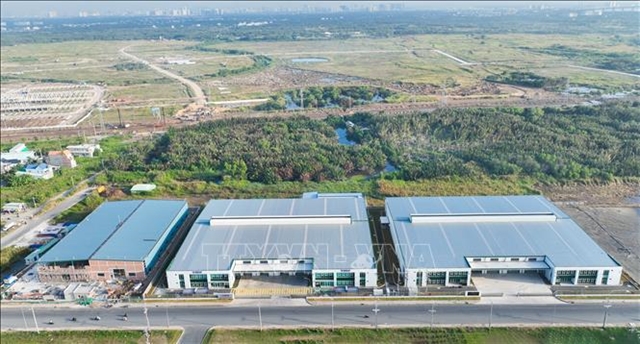 Economy
Economy


|
| A warehouse in the souther province of Long An. The ready-built warehouse market in the southern region including the city is awaiting the outcome of trade negotiations. – VNA/VNS Photo |
HCM CITY — In the face of escalating global economic volatility, particularly following the reciprocal tariffs imbroglio, the ready-built warehouse market in the south, including HCM City, is seeing a lull pending the outcome of trade negotiations.
In its report, real estate services firm JLL Vietnam said the domestic market remains the key to economic resilience.
The Government has responded proactively by implementing and proposing stimulus policies, including the extension of the 2 per cent VAT reduction, which is set to continue until the end of 2026, it said.
The southern ready-built warehouse market saw signs of stability in the first quarter but also caution, it said.
Despite the steady increase in supply thanks to modern projects, the number of new transactions remains low, reflecting the hesitancy of tenants amid the international economic uncertainties, it added.
As of the first quarter, the total prime ready-built warehouse supply in the south was approximately 2.0 million square metres.
Bình Dương Province accounted for over 680,000 sq.m, representing a 33.4 per cent market share, ahead of Đồng Nai (26.0 per cent) and Long An (24.6 per cent).
HCM City was fourth while in Bà Rịa – Vũng Tàu, this segment is still in the early stages of development.
Leasing activities remained steady though subdued in the first quarter, with a number of new transactions recorded, indicating persistent demand for ready-built warehouses.
This was evidenced by the modest quarterly net absorption of around 88,000 sq.m.
Businesses are eagerly awaiting the outcome of the trade negotiations between Việt Nam and the US, especially after the latter announced the tariffs at the end of the first quarter.
JLL said many potential tenants have postponed new leasing and expansion decisions as a result.
According to Trang Lê, general director of JLL Vietnam, in the medium term, the prospects for the southern market remain positive thanks to the entry of international investors.
Japan’s Mitsubishi Estate Asia (MEA) and Singapore’s Sembcorp have announced plans for warehousing and logistics projects over the next five years.
This is expected to be a significant driver of innovation and competition, helping the market maintain its position as a logistics hub in the south.
Challenges also exist, including internal regional competition, increasing investment costs and apprehension among international tenants.
JLL said while the ready-built factory market has yet to show evident signs of impact, Việt Nam could face challenges due to the US tariffs.
Potential economic uncertainties in the coming period are likely to constrain production activities, thereby impacting industrial property demand in the near term.
With new supply steadily coming into the market, competition is sure to intensify among developments.
Total supply reached 5.5 million square metres, representing year-on-year growth of 15.6 per cent.
According to JLL, supply is set for expansion through the remainder of 2025, with around 250,000 sq.m of new factory space expected to launch across key provinces in the next nine months.
In response, landlords are anticipated to maintain a short-term strategy of competitive rents to attract tenants.
Bình Dương led demand, with most new absorption occurring in projects in Thủ Dầu Một and Bàu Bàng districts. Its overall occupancy rate rose up 5.7 per cent year-on-year to 87.3 per cent.
The average asking rent has also been increasing steadily, rising by 1.9 per cent year-on-year to $4.9 per square metre per month.
The upward trend in rents was observed across the south. – VNS




